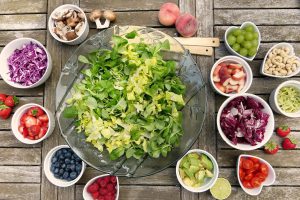Sugar Breakdown
 Sugar is a hot topic today because of the belief that it causes all kinds of health problems like obesity, type 2 diabetes, and heart disease. While sugar isn’t the only thing that contributes to health problems, we still need to limit how much of it we eat. There are a couple of things that make sugar a problem for our health. One problem is the amount of sugar we eat. As Americans, we eat about twice as much sugar as we should. Another problem is the type of sugar that we eat. Natural sugar is found naturally in foods like fruits, vegetables, and dairy products. On the other hand, added sugar is added to a food or drink when it’s being made, like in packaged foods, soft drinks, or homemade desserts. Added sugar is the type of sugar that can contribute to health problems like obesity, type 2 diabetes, and heart disease.
Sugar is a hot topic today because of the belief that it causes all kinds of health problems like obesity, type 2 diabetes, and heart disease. While sugar isn’t the only thing that contributes to health problems, we still need to limit how much of it we eat. There are a couple of things that make sugar a problem for our health. One problem is the amount of sugar we eat. As Americans, we eat about twice as much sugar as we should. Another problem is the type of sugar that we eat. Natural sugar is found naturally in foods like fruits, vegetables, and dairy products. On the other hand, added sugar is added to a food or drink when it’s being made, like in packaged foods, soft drinks, or homemade desserts. Added sugar is the type of sugar that can contribute to health problems like obesity, type 2 diabetes, and heart disease.
To understand the difference between natural and added sugar, think about an orange versus orange juice. The orange has natural sugar, but when it is made into orange juice, a lot of sugar is added. The whole orange also has more fiber than orange juice, which helps prevent blood sugar spikes. Fiber is one reason why whole fruits and vegetables are better choices than juices. Like oranges, plain yogurt and milk also have natural sugar, but when flavored yogurt or milk is made, sugar is added. That added sugar is what we want to avoid.
We should limit how much sugar we eat daily to less than 10% of our calories. So, if you eat 2,000 calories every day, you should only have 200 calories or less from added sugar. That means you should avoid eating more than 50 grams or 12 teaspoons of sugar daily. To help you picture this, a 12-ounce can of cola has about 10 teaspoons of sugar. That’s over 80% of the amount of sugar most of us should be eating in one day!
All kinds of packaged foods and drinks can have added sugars, but the main sources of added sugar are sodas, energy drinks, sports drinks, fruit drinks, sweetened teas, candy, cakes, cookies, pies, pastries, donuts, and dairy desserts like ice cream. It can be hard to find added sugars in packaged foods’ ingredient lists because sugar has other names besides “sugar.” Here are some of those other names that mean sugar has been added:
- Anhydrous dextrose
- Brown sugar
- Confectioner’s powdered sugar
- Corn syrup (or corn syrup solids)
- Dextrose
- Fructose
- High fructose corn syrup (HFCS)
- Honey
- Invert sugar
- Lactose
- Malt syrup
- Maltose
- Maple syrup
- Molasses
- Nectar (e.g. peach nectar)
- Pancake syrup
- Raw sugar
- Sucrose
- Sugar
- White granulated sugar
You may hear that sweeteners like honey, agave, and cane sugar are natural sugars. While they may be grown naturally, they aren’t found naturally in the foods they’re added to and don’t have any health benefits. So they are still considered added sugars that can be harmful to your health. When you think about natural sugars, think about fruits, vegetables, and dairy products.
Sugar can also hide on Nutrition Facts labels because the label may not say if the sugar is added or natural. That’s because a food or drink may have both natural and added sugars. By the year 2021, all food labels will have to show added sugars on the Nutrition Facts label, making it easier to find how much of the sugar in a food or drink is added sugar. Some food labels already have this new label (see an example here). Also, while some packages may say the food or drink is made with “less sugar,” it might still have a lot of sugar. This is why it’s important to read the Nutrition Facts label to see just how much sugar is in a food or drink.
As you can see, sugar is in a lot of foods and drinks, making it hard to eat less of it. Here are some tips to help you eat less added sugar:
- Drink more water and non-fat or low-fat milk instead of drinks sweetened with sugar.
- Instead of soda, try a fruity fizz using seltzer water. Seltzer water is fizzy like soda, but has less sugar.
- Pay attention when you’re grocery shopping and buy products without added sugar. We know that desserts and soft drinks have added sugar, but look out for foods like breakfast cereal, granola, frozen foods, granola bars, sauces, dried fruit, and other condiments that you may not expect to have added sugar.
- Keep lower sugar snacks on hand. It’s easy to go overboard with added sugar when you’re snacking. Try satisfying snacks with less added sugar like an apple or banana with peanut butter; whole grain crackers with low-fat cheese; plain yogurt with berries; mashed avocado with whole grain tortilla chips; a hard boiled egg with a piece of fruit; or raw vegetables (like carrots, cucumber, broccoli, celery, or bell pepper) with hummus.
- When you want a sweet treat, bake from scratch instead of buying sweets at the store so you can control how much sugar you add. Try using apples, bananas, sweet potatoes, and pumpkin for extra sweetness and flavor instead of sugar. Ripe bananas that have started to turn brown are naturally very sweet, so you may try mashing one up and adding it to muffin batter. This way you can add less sugar and still get a sweet taste.
- You can still enjoy some food and drinks with added sugar. Just try eating less at a time and eating them less often.
What are some other ways you can eat less added sugar?
-Cara Mowery
Build Your Own Dressing

Serving Size: 1 teaspoon
Ingredients
- Choose 3 tablespoons acid
- Lemon juice
- Rice vinegar
- Red wine vinegar
- Sherry vinegar
- Balsamic vinegar
- White wine vinegar
- Cider vinegar
- Choose ½ cup or less oil
- Olive oil
- Safflower oil
- Canola oil
- Vegetable oil
- Choose ½ teaspoon add-in
- Herbs
- Spices
- Dijon mustard
- Minced shallots
- Minced garlic
- Parmesan cheese
Directions
- Place all ingredients in a jar or plastic container, and shake to mix together.
- Store in refrigerator. Separation is normal. Shake or stir prior to using.
Try these great combinations:
Lemon Vinaigrette
- 3 tablespoon lemon juice
- ½ cup olive oil
- ½ tablespoon oregano
Balsamic Vinaigrette
- 3 tablespoons balsamic vinegar
- ½ cup olive oil
- ½ tablespoon oregano
Source: Cooking with EFNEP
July is National Culinary Arts Month
We’re celebrating National Culinary Arts Month with some tips to make you more confident cooking nutritious meals on a budget for your family! Cooking can be a bit scary if you haven’t had much practice. Hopefully, these ideas will inspire you to give it a try and get creative in your kitchen!
 Think of your favorite foods you’ve had eating out at a restaurant or at a friend’s house. Try re-creating one of those dishes at home. The great thing about cooking is that you can control what goes in it. If some of your family’s favorite foods are high in fat, salt, and sugar, you can make healthier versions at home. For example, macaroni and cheese is usually made with white pasta and a lot of fat from butter, whole milk or cream, and full-fat cheese. When you make macaroni and cheese at home, you can use whole wheat pasta instead of white pasta. You can also pick what shape pasta you want! Elbows are a traditional choice, but you can also try penne, rotini, and bow-ties. To lower the fat content, you can use plain nonfat yogurt instead of butter, skim milk instead of whole milk, and low-fat cheese instead of full-fat cheese. You can also add vegetables like peas, broccoli, or tomatoes, as well as white beans to add more filling protein and fiber to your meal. This is a great way to sneak a few vegetables into your family meals.
Think of your favorite foods you’ve had eating out at a restaurant or at a friend’s house. Try re-creating one of those dishes at home. The great thing about cooking is that you can control what goes in it. If some of your family’s favorite foods are high in fat, salt, and sugar, you can make healthier versions at home. For example, macaroni and cheese is usually made with white pasta and a lot of fat from butter, whole milk or cream, and full-fat cheese. When you make macaroni and cheese at home, you can use whole wheat pasta instead of white pasta. You can also pick what shape pasta you want! Elbows are a traditional choice, but you can also try penne, rotini, and bow-ties. To lower the fat content, you can use plain nonfat yogurt instead of butter, skim milk instead of whole milk, and low-fat cheese instead of full-fat cheese. You can also add vegetables like peas, broccoli, or tomatoes, as well as white beans to add more filling protein and fiber to your meal. This is a great way to sneak a few vegetables into your family meals.
Spice blends add flavor to the food you cook, but store-bought blends can be expensive and high in salt. Instead, you can make your own homemade spice blends without salt by using individual spices you may already have in your pantry. For more ideas on how to cook with herbs and spices, check out this website. In addition to spice blends, you can add flavor to your food with lemon juice, vinegar, and small amounts of plant-based oil like olive oil.
Cooking a delicious, healthy meal can take time, but there are ways to make it easier. Plan your meals before you go to the grocery store so you’ll have on hand exactly what you need to cook for the week. Also, plan your meals around what ingredients are on sale at the grocery store that week. When you’re cooking, go ahead and double the recipe so you can have leftovers for the next day, or freeze them for another week. Getting five servings of fruits and vegetables in a day can be challenging, but canned and frozen vegetables can be just as nutritious as fresh, and sometimes cheaper when the food you’re buying isn’t in season. Make sure to choose canned and frozen fruits and vegetables without added sugar or salt. Drain and rinse canned vegetables and fruits before you use them to wash away some of the sugar and salt. Having canned and frozen produce on hand is a great way to add fruits and vegetables to any meal in case you don’t have fresh ones to cook with–plus the canned and frozen won’t spoil as quickly!
Lastly, involve your family in the cooking process! Even young children can help with mixing, measuring, stirring, and setting the table. This is a great way to bond as a family and make your family more willing to try what you made since they’ll play a part in the cooking process. Cooking doesn’t always have to be exact, so there’s room to be creative and customize your dishes to how you like them.
What can you cook in your kitchen this week?
-Cara Mowery
Relay Race

Relay races are a fun way for kids, especially preschoolers, to learn sportsmanship as they compete against other teams to win. They’re a great activity to include in your summer cookouts and neighborhood block parties with friends and family. There are many ways to play, but you usually will split into two (or more) teams with an equal number of players on each team. Leaving plenty of space in between teams, each team stands in a line as one player at a time goes from the start to a certain point ahead of them (perhaps 20 feet, more or less depending on your children’s age and skill level), and back to the start, doing a movement like running or skipping. After one player returns to the start, the next player takes their turn. The team whose players complete their turns first wins the game.
Before playing, make sure there’s enough room to race safely without obstacles like rocks and away from potentially dangerous objects like barbecue grills. An open backyard or field at a park away from the road are great locations to do relay races. Even the adults can participate with the children! You can make teams by family, who has a summer birthday vs. who doesn’t, and whatever other criteria you can think of.
Here’s a list of different relay races your children can try:
- Crab Walk Race: Each player will crab walk when they take their turn. To crab walk, sit on the ground and lift yourself up with your hands and feet. On all fours, walk sideways to the other side and back to the start.
- Three-Legged Race: Teams should be split into pairs. Tying one players right leg to another player’s left leg with a bandana or scarf, pairs of players go to the other side and back to the start with one of each of their legs tied together. The key is to move at the same pace as the player tied to you so you can move faster and without tripping.
- Spoon Race: Players will walk normally, but while carrying a spoon with a hard-boiled or plastic egg on it. If a player drops their egg, they have to pick it up and put it back on their spoon before continuing. You can also try this with other objects that are hard to balance, such as water balloons.
- Wheelbarrow Race: Like the three-legged race, each team should be split into pairs. One player (the wheelbarrow) walks on their hands while the other player holds the “wheelbarrow’s” ankles as they walk. After getting to the other side, players should switch places and then return to the start.
For more relay race ideas, visit https://pbskids.org/zoom/activities/games/.
What’s your child’s favorite way to relay?
National Park and Recreation Month

July is National Park and Recreation Month! The National Recreation and Park Association (NRPA) exists to promote public parks, recreation, and conservation. Children with access to safe parks and recreation are more likely to participate in physical activity,¹ so parks play a critical role in children’s health. This month, get your children outside and utilize the plethora of activities provided by parks and recreational activities!
Here are some ways you and your family can participate in National Park and Recreation Month!
- Playgrounds: Playgrounds provide all kinds of activities that young children especially will enjoy. Equipment like monkey bars help children build strong bones and muscles. Also, taking turns on the equipment can help children learn manners and sharing.
- Fishing: Fishing is a fun way to enjoy the outdoors and get physical activity without overly exerting yourself on a hot July day. State parks with bodies of water are often available for fishing as long as you have a fishing license and abide by state regulations.
- Boating and paddling: Many state parks have bodies of water flowing through them. These provide great opportunities to see the beauty of the park while getting physical activity by boating through the park. Oftentimes you can rent a canoe, kayak, or paddleboat to explore the water.
- Rock climbing: While children should learn to climb indoors before trying outdoor climbing, rock climbing is a great strength-building activity. Older, more experienced children may enjoy climbing outdoors under adult supervision and with an appropriate permit from the park office.
Whether you visit a local park or a state park, you’re sure to find activities the whole family will enjoy! To find a park near you, visit https://findyourpark.com.
What will your children play at the park?
References